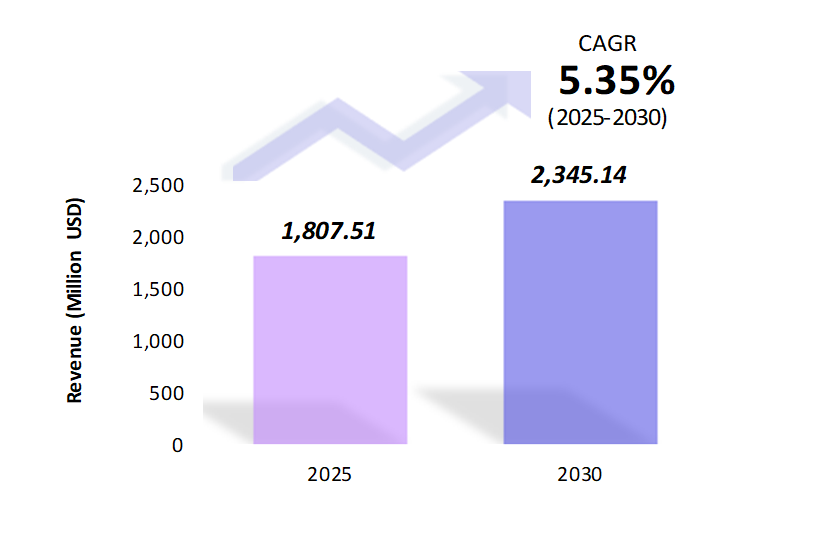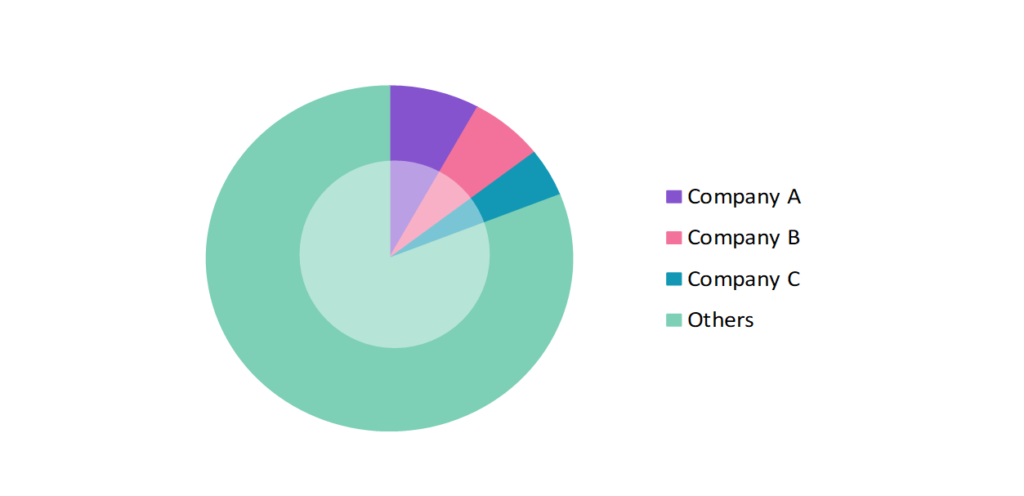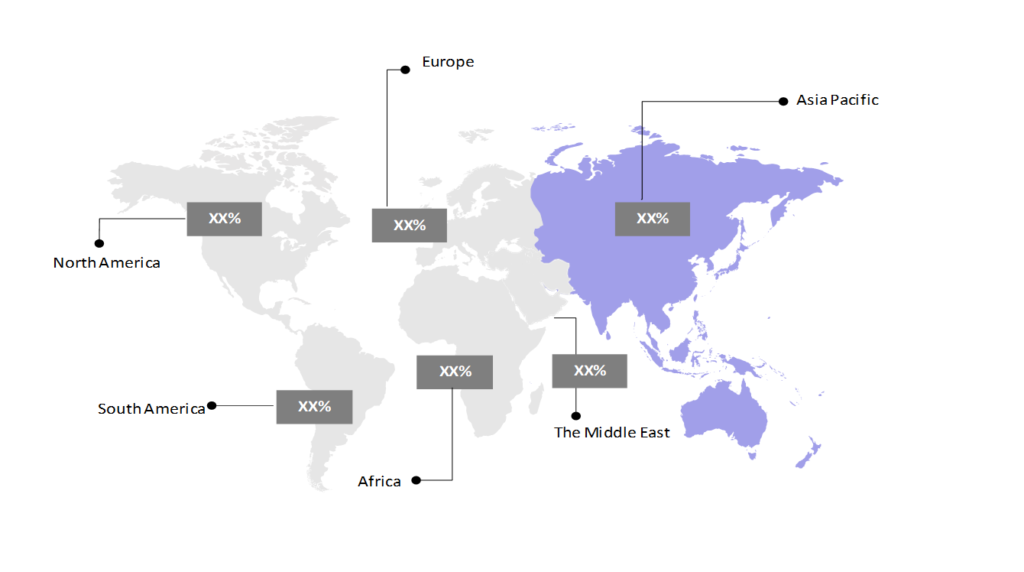Portable Projector Market Outlook: Size, Share, Trends & Growth Analysis (2024-2029)
The market report presents a thorough analysis segmented by Technology (Digital Light Processing (DLP), Liquid Crystal Display (LCD), Liquid Crystal on Silicon (LCoS)); by Application (Education, Enterprise, Consumer, Healthcare, Others); by Geography (North America, South America, Asia Pacific, Europe, The Middle East, Africa).
Outlook

- The portable projector market is estimated to be at USD 1,807.51 Mn in 2025 and is anticipated to reach USD 2,345.14 Mn in 2030.
- The portable projector market is registering a CAGR of 5.35% during the forecast period 2025-2030.
- The portable projector market is experiencing significant growth driven by advancements in display technology and increasing demand for versatile educational and professional tools. Key trends include the adoption of laser and LED light sources, enhanced connectivity features, and integration with smart technologies. The rise of remote learning and telemedicine further fuels the need for portable projection solutions. As consumer preferences shift towards compact, high-performance devices, the market is poised for continued innovation and expansion.
Request a free sample.
Ecosystem

- The participants in the global portable projector industry are always developing their strategies to preserve a competitive advantage.
- Companies invest in research and development to integrate the latest technologies, such as wireless connectivity, Artificial Intelligence (AI) capabilities, and enhanced user interfaces, to meet evolving consumer needs.
- Several important entities in the portable projector market include Seiko Epson Corp.; Canon Inc.; LG Corp.; Eastman Kodak Co.; Koninklijke Philips N.V.; and others.
Ask for customization.
Findings
| Attributes | Values |
|---|---|
| Historical Period | 2019-2023 |
| Base Year | 2024 |
| Forecast Period | 2025-2030 |
| Market Size (2025) | USD 1,807.51 Mn |
| Market Size (2030) | USD 2,345.14 Mn |
| Growth Rate | 5.35% CAGR from 2025 to 2030 |
| Key Segments | Technology (Digital Light Processing (DLP), Liquid Crystal Display (LCD), Liquid Crystal on Silicon (LCoS)); Application (Education, Enterprise, Consumer, Healthcare, Others); Geography (North America, South America, Asia Pacific, Europe, The Middle East, Africa) |
| Key Vendors | Seiko Epson Corp.; Canon Inc.; LG Corp.; Eastman Kodak Co.; Koninklijke Philips N.V. |
| Key Countries | The US; Canada; Mexico; Brazil; Colombia; Ecuador; China; Singapore; Japan; Malaysia; The UK; Germany; France; Netherlands; Jordan; UAE; Saudi Arabia; Egypt; South Africa |
| Largest Market | Asia Pacific |
Get a free quote.
Trends
- Use of Laser and LED Light Source Technology: Many portable projectors now use laser and LED light sources, which offer longer lifespans and higher brightness levels compared to traditional lamps. LED and laser-based models are increasingly compact, producing vibrant colors without the need for regular bulb replacements. The Anker Nebula Cosmos Laser 4K projector features a laser light engine that provides high brightness and a longer lifespan, which eliminates the need for frequent bulb changes.
- Integration of Smart Features with Built-in Streaming: Integrated smart platforms like Android TV, Roku, or custom OSs allow users to stream content directly from services like Netflix, YouTube, or Amazon Prime without needing external devices. Voice control features, such as Google Assistant and Amazon Alexa, are also being integrated into portable projectors for a hands-free experience.
- Multi-device Connectivity and Wireless Casting: Innovations in wireless casting have enabled portable projectors to seamlessly mirror content from smartphones, tablets, and laptops via Wi-Fi, Bluetooth, or USB-C, which improves user convenience. Devices now support Chromecast or AirPlay for better compatibility with both Android and iOS devices, which enables quick content sharing during travel or presentations. Xgimi MoGo Pro portable projector supports wireless casting via Chromecast and AirPlay, which allows users to seamlessly mirror content from smartphones, tablets, and laptops.
Speak to analyst.
Catalysts
- Digital Transformation in the Education Sector: The shift towards digital education is accelerating, with schools and institutions increasingly adopting digital tools to enhance learning experiences. Portable projectors play a key role in this transformation by providing flexible, interactive visual aids in both classrooms and remote learning environments. These projectors enable educators to deliver dynamic presentations, share multimedia content, and facilitate collaborative learning sessions.
- Increasing Focus on Personalized and Adaptive Learning: There is a growing emphasis on personalized and adaptive learning, where education is tailored to individual student needs and learning styles. Portable projectors support this by offering interactive and engaging ways to present tailored content in small groups or individual study sessions. By integrating with educational apps and tools, portable projectors help create adaptive learning environments that promote student engagement and foster personalized education paths.
- Increasing Use of Portable Projectors in Medical Training and Telemedicine: Portable projectors are increasingly being used in healthcare for medical training, patient education, and telemedicine applications. These devices allow medical professionals to display high-resolution images, instructional videos, and 3D simulations in a wide range of environments, including hospitals, training rooms, and even remote areas. Epson PowerLite 1795F lightweight, portable projector is utilized in medical training sessions to display high-resolution anatomical images, instructional videos, and complex 3D simulations to medical students and professionals.
Inquire before buying.
Restraints
- Operational Challenges for Low-End Models: Low-end portable projectors often face operational issues such as lower brightness levels, limited resolution, and shorter battery life. These limitations reduce their effectiveness in brightly lit environments or larger spaces, which makes them less suitable for professional or educational use. Additionally, such models may lack essential features like wireless connectivity or sufficient storage, which leads to performance issues during prolonged or high-demand usage.
- Limited Upgradability: Many portable projectors, especially in the lower to mid-range segments, offer limited upgradability in terms of hardware and software. Once purchased, users are often unable to upgrade components such as light sources, resolution capabilities, or operating systems. This restriction can lead to rapid obsolescence as new features or technologies become available, reducing the long-term value of these devices.
- Complexities in Integration with Emerging Technologies: As technology advances, portable projectors face increasing challenges in integrating with emerging technologies like 5G, artificial intelligence, and virtual reality. Many models struggle to keep pace with the connectivity and processing requirements of these technologies, which leads to compatibility issues. This can complicate their use in professional or educational settings where seamless integration with advanced systems and software is necessary for optimal performance.
Personalize this research.
Hotspot

Explore purchase options.
Table of Contents
| 1. Introduction 1.1. Research Methodology 1.2. Scope of the Study 2. Market Overview / Executive Summary 2.1. Global Portable Projector Market (2019 – 2023) 2.2. Global Portable Projector Market (2024 – 2030) 3. Market Segmentation 3.1. Global Portable Projector Market by Technology 3.1.1. Digital Light Processing (DLP) 3.1.2. Liquid Crystal Display (LCD) 3.1.3. Liquid Crystal on Silicon (LCoS) 3.2. Global Portable Projector Market by Application 3.2.1. Education 3.2.2. Enterprise 3.2.3. Consumer 3.2.4. Healthcare 3.2.5. Others 4. Regional Segmentation 4.1. North America 4.1.1. The US 4.1.2. Canada 4.1.3. Mexico 4.2. South America 4.2.1. Brazil 4.2.2. Colombia 4.2.3. Ecuador 4.2.4. Rest of South America 4.3. Asia Pacific 4.3.1. China 4.3.2. Singapore 4.3.3. Japan 4.3.4. Malaysia 4.3.5. Rest of Asia Pacific 4.4. Europe 4.4.1. The UK 4.4.2. Germany 4.4.3. France 4.4.4. Netherlands 4.4.5. Rest of Europe 4.5. The Middle East 4.5.1. Jordan 4.5.2. UAE 4.5.3. Saudi Arabia 4.5.4. Rest of the Middle East 4.6. Africa 4.6.1. Egypt 4.6.2. South Africa 4.6.3. Rest of Africa 5. Value Chain Analysis of the Global Portable Projector Market 6. Porter Five Forces Analysis 6.1. Threats of New Entrants 6.2. Threats of Substitutes 6.3. Bargaining Power of Buyers 6.4. Bargaining Power of Suppliers 6.5. Competition in the Industry 7. Trends, Drivers and Challenges Analysis 7.1. Market Trends 7.1.1. Market Trend 1 7.1.2. Market Trend 2 7.1.3. Market Trend 3 7.2. Market Drivers 7.2.1. Market Driver 1 7.2.2. Market Driver 2 7.2.3. Market Driver 3 7.3. Market Challenges 7.3.1. Market Challenge 1 7.3.2. Market Challenge 2 7.3.3. Market Challenge 3 8. Opportunities Analysis 8.1. Market Opportunity 1 8.2. Market Opportunity 2 8.3. Market Opportunity 3 9. Competitive Landscape 9.1. Seiko Epson Corp. 9.2. Canon Inc. 9.3. LG Corp. 9.4. Eastman Kodak Co. 9.5. Koninklijke Philips N.V. 9.6. Company 6 9.7. Company 7 9.8. Company 8 9.9. Company 9 9.10. Company 10 |
Know the research methodology.
Portable Projector Market – FAQs
1. What is the current size of the portable projector market?
Ans. In 2025, the portable projector market size is USD 1,807.51 Mn.
2. Who are the major vendors in the portable projector market?
Ans. The major vendors in the portable projector market are Seiko Epson Corp.; Canon Inc.; LG Corp.; Eastman Kodak Co.; Koninklijke Philips N.V.
3. Which segments are covered under the portable projector market segments analysis?
Ans. The portable projector market report offers in-depth insights into Technology, Application, and Geography.
